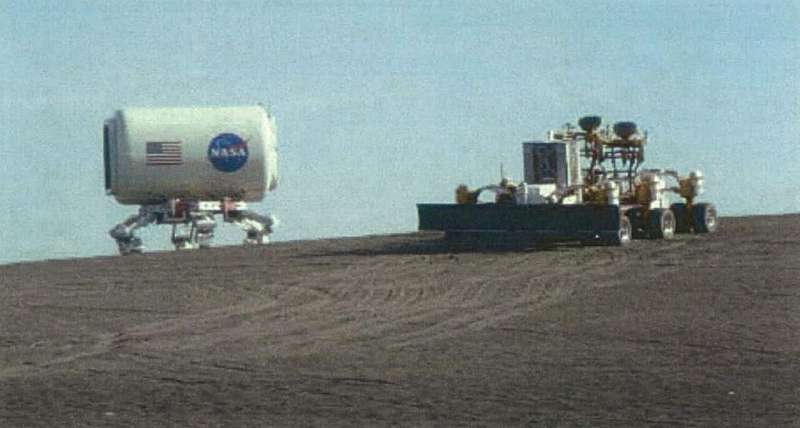This article has been reviewed according to Science X's editorial process and policies. Editors have highlighted the following attributes while ensuring the content's credibility:
fact-checked
trusted source
proofread
A handy attachment could make lunar construction a breeze

Moving large amounts of regolith is a requirement for any long-term mission to the moon or Mars. But so far, humanity has only sent systems capable of moving small amounts of soil at a time—primarily for sample collection. Sending a large, dedicated excavator to perform such work might be cost-prohibitive due to its weight, so why not send a bulldozer attachment to a mobility unit already planned for use on the surface?
That was the thought process of an interdisciplinary team of engineers from NASA and the Colorado School of Mines. They came up with the Lunar Attachment Node for Construction and Excavation—or LANCE.
LANCE is an attachment to NASA's Chariot rover prototype, which was originally designed to be the primary mobility system for astronauts returning to the moon. However, it was designed in 2007, when the original NASA Lunar Architecture plan was to establish a permanent lunar base in 2019.
That still has yet to happen, and the Chariot system has recently been replaced by two separate rovers for use in the Artemis missions—one pressurized for longer exploratory trips and one unpressurized for short jaunts around the Artemis base site. However, the concept of LANCE should be adaptable to whatever method NASA finally uses to transport humans on the lunar surface.
While LANCE looks like a simple bulldozer blade, its design is made specifically for use on the lunar surface. Its frame is aluminum rather than steel, a nod to the weight restrictions on space missions. Its curved front end, called a moldboard in excavation terms, is made of a combination of carbon fiber composites and epoxy, which were even more rarely used back in 2009 when the system was initially proposed.
Engineers even produced a prototype after extensive Finite Element Analysis modeling of the expected forces on the blade during several types of actions, such as building roads, landing pads, and berms that could block debris scatter from affecting surrounding equipment during rocket landings and ascents. The prototype was tested at a natural test site in Moses Lake, Washington.
Moses Lake proved an ideal training ground for lunar excavation equipment because of a highly cohesive silt deposited by the Mount St Helens eruption in 1980. The silt proved similar to lunar regolith, but without the requirement to move thousands of tons of simulated regolith to a NASA lab somewhere. So, NASA has been using the site as a test bed for large-scale lunar excavations for years.
LANCE performed admirably well during its test phase. It leveled a 25m x 25m area, then moved on to some berm construction. As part of the testing, it quickly became apparent that operator efficiency made a massive difference in how quickly these operations were performed, so whoever ends up using the implement on the lunar surface would benefit from sufficient training beforehand.
But if it ever does end up operational on the Lunar surface, LANCE will have to contend with a very different environment than it did at Moses Lake. Lunar regolith is much more electrostatically charged than volcanic silt, and the lower gravity could make the forces of moving it much more difficult, despite the best modeling efforts of LANCE's design team.
It is unclear if LANCE will indeed be part of the Artemis missions, though large-scale excavation equipment will be needed as part of the mission architecture. What will remain to be seen is whether LANCE's development and testing show that it should be possible to utilize a lightweight, flexible attachment to a rover to help build the infrastructure necessary to support a long-term base on the lunar surface.
Provided by Universe Today





















